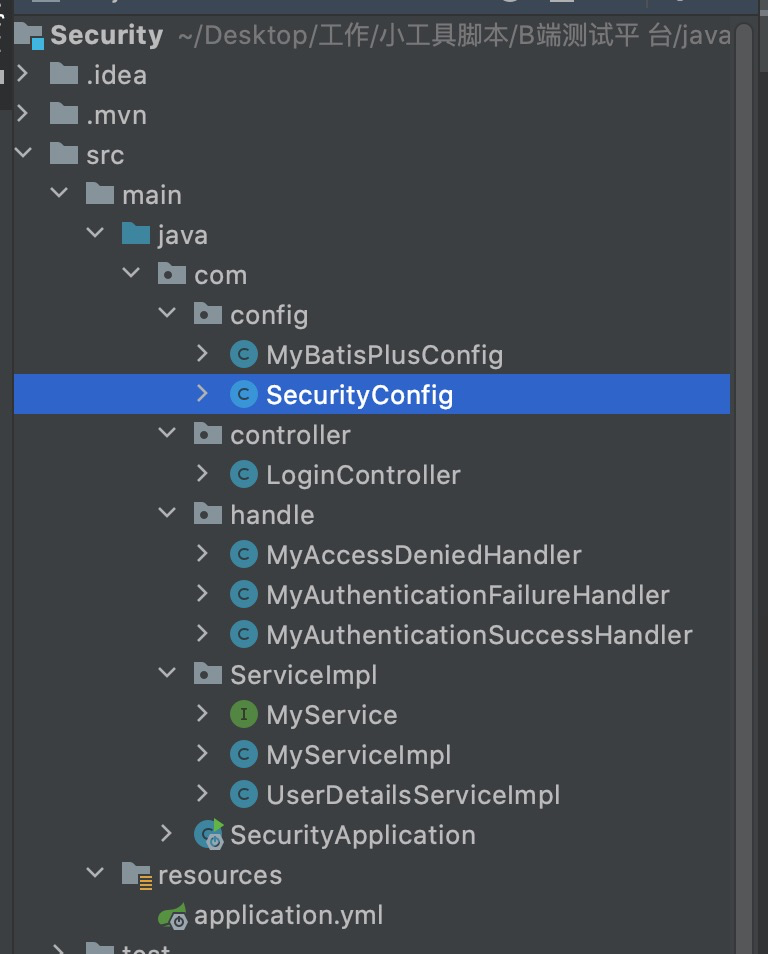参考: https://www.bilibili.com/video/BV17h41147Jq
maven依赖
<dependency>
<groupId>org.springframework.boot</groupId>
<artifactId>spring-boot-starter-security</artifactId>
</dependency>---发现加了依赖其实就生效了,访问 /login 就是security默认登录页面
账号 user 密码 在控制台打印有(每次启动都是不一样的)

查看密码加密后是否一致的方法 -----自定义登录需要,因为正常存入数据库密码为加密的,先用账户名查到对应密码 把前端传过来的密码加密看看是否和一致
import org.springframework.security.crypto.bcrypt.BCryptPasswordEncoder;
import org.springframework.security.crypto.password.PasswordEncoder;
@GetMapping("/checkpwd")
public boolean pwd() {
PasswordEncoder pe =new BCryptPasswordEncoder();
String encode =pe.encode("123");
System.out.println(encode);
return pe.matches("123",encode);
}已下为我的实战
一、目录结构

MyBatisPlusConfig
package com.config;
import com.baomidou.mybatisplus.extension.plugins.PerformanceInterceptor;
import org.springframework.context.annotation.Bean;
import org.springframework.context.annotation.Configuration;
//MyBatisPlus配置
@Configuration
public class MyBatisPlusConfig {
// sql执行效率插件
@Bean
public PerformanceInterceptor PerformanceInterceptor(){
PerformanceInterceptor PerformanceInterceptor = new PerformanceInterceptor();
PerformanceInterceptor.setMaxTime(1111);//设置sql执行的最大时间,如果超过了则不执行,抛异常
PerformanceInterceptor.setFormat(true); //开启sql格式化
return PerformanceInterceptor;
}
}
SecurityConfig
package com.config;
import com.handle.MyAccessDeniedHandler;
import com.handle.MyAuthenticationFailureHandler;
import com.handle.MyAuthenticationSuccessHandler;
import org.springframework.beans.factory.annotation.Autowired;
import org.springframework.context.annotation.Bean;
import org.springframework.context.annotation.Configuration;
import org.springframework.http.HttpMethod;
import org.springframework.security.config.annotation.authentication.builders.AuthenticationManagerBuilder;
import org.springframework.security.config.annotation.web.builders.HttpSecurity;
import org.springframework.security.config.annotation.web.configuration.WebSecurityConfigurerAdapter;
import org.springframework.security.core.userdetails.UserDetailsService;
import org.springframework.security.crypto.password.PasswordEncoder;
import org.springframework.security.web.authentication.AuthenticationFailureHandler;
import org.springframework.security.crypto.bcrypt.BCryptPasswordEncoder;
import org.springframework.security.web.authentication.rememberme.JdbcTokenRepositoryImpl;
import org.springframework.security.web.authentication.rememberme.PersistentTokenRepository;
import javax.sql.DataSource;
@Configuration
@EnableWebSecurity //加不加都行
public class SecurityConfig extends WebSecurityConfigurerAdapter {
//引入自定义异常处理类
@Autowired
private MyAccessDeniedHandler myAccessDeniedHandler;
//自定义登录逻辑
@Autowired
private UserDetailsService userDetailsService;
//持久化数据库操作
@Autowired
private DataSource dataSource;
@Autowired
private PersistentTokenRepository persistentTokenRepository;
@Override
protected void configure(HttpSecurity http) throws Exception{
//授权认证
http.authorizeRequests()
// 内置访问方法
//设置不需要认证都可以访问的链接,结合通配符--
// 下面的另外一种写法,.antMatchers("/loginfail/**","/login/**").sccess("permitAll()")
// ?: 匹配一个字符
// * : 匹配多个字符
// ** : 匹配0个或多个目录
// .antMatchers("/loginfail/**","/login/**","/no").permitAll()
// 放行相关文件
.antMatchers("/**/**.png").permitAll()
// 指定这个接口只能使用POST请求 才能放行
.regexMatchers(HttpMethod.POST,"/hah").permitAll()
// 正则表达式匹配链接
.regexMatchers(".+[*]png").permitAll()
// 指定访问这个接口uri要加上/xxx
.mvcMatchers("/demo").servletPath("/xxx").permitAll()
//权限控制
// 指定单个权限可访问地址
// .antMatchers("/no").hasAuthority("admin")
// 指定多个权限可访问地址--也可以直接传多个权限的字符"admin,normal"
// .antMatchers("/no").hasAnyAuthority("admin","normal")
// 指定一个角色可以访问的地址
// .antMatchers("/no").hasRole("abc2")
// 指定多个角色可以访问的地址--也可以直接传多个角色的字符"abc2,abc",自定义登录角色设置为ROLE_abc,这里指定abc即可
// .antMatchers("/no").hasAnyRole("abc2","abc")
// 指定接口可以访问的服务器IP,一般用于微服务,指定某个服务可调用我们
// .antMatchers("/no").hasIpAddress("192.168.101")
//所有请求都必须被认证,必须登录之后才被访问
.anyRequest().authenticated();
// 自定义方法实现权限----登录后,再访问uri走这个逻辑判断
// .anyRequest().access("@myServiceImpl.hasPermission(request,authentication)");
// 没有权限默认跳转到登录页面,要把不用权限访问的uri先配置好
//登录表单提交
http.formLogin()
.usernameParameter("user") //接收user作为账号--定义接口传的餐素
.passwordParameter("pwd") //接收pwd作为密码--定义接口传的参数
.loginProcessingUrl("/ccc") //定义登录接口的uri--改变默认接口请求的/login
//登录成功的动作
// .defaultSuccessUrl("/loginsuccess") //登录成功后,浏览器页面要跳转的url--这个是get的方法
.successForwardUrl("/loginsuccess") //登录成功后执行这个请求 要用post请求--会把这个方法返回信息响应给前端
// 登录成功自定义处理器,用了successHandler 就不可以用successForwardUrl,不然会报错--
// 可以参考下https://blog.csdn.net/YCJ_xiyang/article/details/95231324?utm_medium=distribute.wap_relevant.none-task-blog-2~default~baidujs_utm_term~default-16.wap_blog_relevant_default&spm=1001.2101.3001.4242.9&utm_relevant_index=19
// .successHandler(new MyAuthenticationSuccessHandler("http://baidu.com"))
//登录失败的动作
.failureForwardUrl("/loginfail") ; //登录失败后执行这个请求 要用post请求--会把这个方法返回信息响应给前端可以控制响应码
// 登录失败自定义处理器,用了failureHandler 就不可以用failureForwardUrl,不然会报错--
// .failureHandler(new MyAuthenticationFailureHandler("http://weixiao.qq.com"));
// 这里也可以用.and()去接着连接
//rememberMe为开启记住我功能--其实就是设置了cookie的有效时长
//做持久化应该试为了服务器重启后,登录态依旧有效
// 持久化记住我功能
http.rememberMe()
//失效时间,单位秒
.tokenValiditySeconds(60)
//自定义记住我 接口传的参数名
.rememberMeParameter("rem")
//自定义登录逻辑
.userDetailsService(userDetailsService) //不做持久化的rememberMe 到这一步就可以了
// //持久层对象
.tokenRepository(persistentTokenRepository);
http.csrf().disable();//禁用跨站csrf攻击防御--开启后接口只需要传账号和密码 可做前后端分离 要加这个 或者等于关闭防火墙
// 自定义403等接口返回,异常处理
http.exceptionHandling()
.accessDeniedHandler(myAccessDeniedHandler);
//注销 开启注销功能--默认就有这个功能
http.logout()
// 更改退出登录的接口uri
.logoutUrl("/user/logout")
// 退出后的跳转页面
.logoutSuccessUrl("/");
}
//重写加密方法给自定义登录逻辑UserDetailsServiceImpl调用
@Bean
public PasswordEncoder getPw(){
return new BCryptPasswordEncoder();
}
//连接数据库做记住我功能持久化
@Bean
public PersistentTokenRepository getPersistenntTokenRepository(){
JdbcTokenRepositoryImpl jdbcTokenRepository =new JdbcTokenRepositoryImpl();
jdbcTokenRepository.setDataSource(dataSource);
//自动建表,第一次启动时需要,第二次启动注释掉!!!!不然会报错
// jdbcTokenRepository.setCreateTableOnStartup(true);
return jdbcTokenRepository;
}
}LoginController
---里面获取用户的身份权限信息User类建议重写User类(比较方便获取信息) 见 https://www.cnblogs.com/kaibindirver/p/16037172.html
package com.controller;
import org.springframework.http.HttpHeaders;
import org.springframework.http.ResponseEntity;
import org.springframework.security.access.annotation.Secured;
import org.springframework.security.access.prepost.PreAuthorize;
import org.springframework.security.core.Authentication;
import org.springframework.security.core.context.SecurityContextHolder;
import org.springframework.security.core.userdetails.User;
import org.springframework.web.bind.annotation.GetMapping;
import org.springframework.web.bind.annotation.PostMapping;
import org.springframework.web.bind.annotation.RestController;
@RestController
public class LoginController {
//角色注解,这个方法只有 ROLE_abc 角色可以访问---注解也可以用在 server层
@Secured("ROLE_abc")
//角色注解,这个方法只有 ROLE_abc 角色可以访问,传参时也可以不加ROLE_
// 在类和方法执前判断角色---注解也可以用在 server层
// @PreAuthorize("hasRole('ROLE_abc')")
@GetMapping("/no")
//获取用户信息的方法 用Authentication类
public String NO(Authentication authentication){
// System.out.println(authentication.getName());
// System.out.println(authentication.getAuthorities());
// System.out.println(authentication.getDetails());
// System.out.println(authentication.getPrincipal());
System.out.println("没有授权不可访问的接口");
return "没有授权不可访问的接口";
}
@PostMapping("/loginsuccess")
public String loginsuccess(){
System.out.println("登录成功请求这个接口");
System.out.println(SecurityContextHolder.getContext()); //获取请求用户的身份
System.out.println(SecurityContextHolder.getContext().getAuthentication().getPrincipal()); //判断用户是否登录
User user=(User) SecurityContextHolder.getContext().getAuthentication().getPrincipal();
System.out.println(user.getUsername()); //账号 为空 框架机制
System.out.println(user.getPassword()); //密码
System.out.println(user.getAuthorities()); //权限
return "登录成功请求这个接口";
}
//登录失败让接口报401
@PostMapping("/loginfail")
public ResponseEntity<String> loginfail(){
HttpHeaders headers = new HttpHeaders();
headers.set("yyyy","111111");
System.out.println("登录失败请求这个接口");
return ResponseEntity.status(401).headers(headers)
.body( "登录失败请求这个接口");
}
@GetMapping("/no2")
//获取用户信息的方法 用Authentication类
public String NO2(Authentication authentication){
// System.out.println(authentication.getName());
// System.out.println(authentication.getAuthorities());
// System.out.println(authentication.getDetails());
// System.out.println(authentication.getPrincipal());
System.out.println("没有授权不可访问的接口2");
return "没有授权不可访问的接口2";
}
}
MyAccessDeniedHandler
package com.handle;
import com.fasterxml.jackson.databind.ObjectMapper;
import org.springframework.beans.factory.annotation.Autowired;
import org.springframework.security.access.AccessDeniedException;
import org.springframework.security.web.access.AccessDeniedHandler;
import org.springframework.stereotype.Component;
import javax.servlet.ServletException;
import javax.servlet.http.HttpServletRequest;
import javax.servlet.http.HttpServletResponse;
import java.io.IOException;
import java.io.PrintWriter;
import java.util.HashMap;
import java.util.Map;
//重写自定义403、401等接口的响应
@Component
public class MyAccessDeniedHandler implements AccessDeniedHandler {
@Autowired
private ObjectMapper objectMapper;
@Override
public void handle(HttpServletRequest httpServletRequest, HttpServletResponse httpServletResponse, AccessDeniedException e) throws IOException, ServletException {
// 设置需要响应状态码
httpServletResponse.setStatus(HttpServletResponse.SC_FORBIDDEN);
httpServletResponse.setHeader("Content-type","text/html;charset=UTF-8");
PrintWriter writer = httpServletResponse.getWriter();
Map<String,Object> map = new HashMap<String,Object>();
map.put("code",403);
map.put("message","没有访问权限");
writer.write(objectMapper.writeValueAsString(map));
writer.flush();
writer.close();
}
}
MyAuthenticationFailureHandler
package com.handle;
import org.springframework.security.core.AuthenticationException;
import org.springframework.security.web.authentication.AuthenticationFailureHandler;
import javax.servlet.ServletException;
import javax.servlet.http.HttpServletRequest;
import javax.servlet.http.HttpServletResponse;
import java.io.IOException;
//配置文件 failureHandler-登录失败处理器 走下面的方法
public class MyAuthenticationFailureHandler implements AuthenticationFailureHandler {
private String url;
public MyAuthenticationFailureHandler(String url){
this.url=url;
}
@Override
public void onAuthenticationFailure(HttpServletRequest httpServletRequest, HttpServletResponse httpServletResponse, AuthenticationException e) throws IOException, ServletException {
//重定向地址
httpServletResponse.sendRedirect(url);
}
}
MyAuthenticationSuccessHandler
package com.handle;
import org.springframework.security.core.Authentication;
import org.springframework.security.core.userdetails.User;
import org.springframework.security.web.authentication.AuthenticationSuccessHandler;
import javax.servlet.ServletException;
import javax.servlet.http.HttpServletRequest;
import javax.servlet.http.HttpServletResponse;
import java.io.IOException;
//配置文件 successHandler-登录成功处理器 走下面的方法
public class MyAuthenticationSuccessHandler implements AuthenticationSuccessHandler {
private String url;
public MyAuthenticationSuccessHandler (String url){
this.url=url;
}
@Override
public void onAuthenticationSuccess(HttpServletRequest httpServletRequest, HttpServletResponse httpServletResponse, Authentication authentication) throws IOException, ServletException {
//获取发送请求的服务器IP地址
System.out.println(httpServletRequest.getRemoteAddr());
// ---获取用户的提交信息
User user= (User) authentication.getPrincipal();
//获取身份和权限
System.out.println(user.getAuthorities());
//获取登录的账号
System.out.println(user.getUsername());
//框架的安全机制,获取登录密码输出为null
System.out.println(user.getPassword());
//重定向地址
httpServletResponse.sendRedirect(url);
}
}
MyService
package com.ServiceImpl;
import org.springframework.security.core.Authentication;
import javax.servlet.http.HttpServletRequest;
//自定义方法实现权限控制的接口
public interface MyService {
boolean hasPermission(HttpServletRequest request, Authentication authentiication);
}
MyServiceImpl。 -------感觉可以在这块查数据库 判断这个账号的权限
package com.ServiceImpl;
import org.springframework.security.core.Authentication;
import org.springframework.security.core.GrantedAuthority;
import org.springframework.security.core.authority.SimpleGrantedAuthority;
import org.springframework.security.core.userdetails.UserDetails;
import org.springframework.stereotype.Service;
import javax.servlet.http.HttpServletRequest;
import java.util.Collection;
@Service
public class MyServiceImpl implements MyService{
//自定义方法实现权限控制---登录后 再访问uri 才会走这个逻辑
@Override
public boolean hasPermission(HttpServletRequest request, Authentication authentication) {
Object obj = authentication.getPrincipal();
System.out.println("看是什么用户");
System.out.println(obj);
// 判断用户是否赋予权限
if (obj instanceof UserDetails){
UserDetails userDetails = (UserDetails) obj;
System.out.println("用户已登录的信息");
System.out.println(userDetails);
Collection<? extends GrantedAuthority> authorities=userDetails.getAuthorities();
System.out.println(authorities); //打印角色和权限 [ROLE_abc, add, admin, delete]
System.out.println(new SimpleGrantedAuthority(request.getRequestURI())); //当前用户访问的uri
System.out.println(authorities.contains(new SimpleGrantedAuthority(request.getRequestURI())));
return authorities.contains(new SimpleGrantedAuthority(request.getRequestURI())); //判断是否有权限访问,没有就返回false
}
return false;
}
}
UserDetailsServiceImpl
package com.ServiceImpl;
import org.springframework.beans.factory.annotation.Autowired;
import org.springframework.security.core.authority.AuthorityUtils;
import org.springframework.security.core.userdetails.User;
import org.springframework.security.core.userdetails.UserDetails;
import org.springframework.security.core.userdetails.UserDetailsService;
import org.springframework.security.core.userdetails.UsernameNotFoundException;
import org.springframework.security.crypto.password.PasswordEncoder;
import org.springframework.stereotype.Service;
//登录时的自定义逻辑实现
@Service
public class UserDetailsServiceImpl implements UserDetailsService {
@Autowired
private PasswordEncoder pw;
//登录的时候会触发这个实现类,在这里写逻辑去校验
@Override
public UserDetails loadUserByUsername(String username) throws UsernameNotFoundException {
// 获取请求的账号
System.out.println(username);
//1、查询数据库判断用户是否存在,如果不存在会抛出UsernameNotFoundException异常
if (!"lucax".equals(username)) {
System.out.println("用户不存在");
throw new UsernameNotFoundException("用户不存在!");
}
else{
// 2、根据用户名从数据库把查询出来的密码(注册时已加密过) 进行解析,或者直接把密码放入构造方法
String password = pw.encode("123456");
System.out.println("用户存在");
//账号密码符合,存在给用户赋予权限和角色
return new User(
// admin,normal 是权限
username, password,
AuthorityUtils.commaSeparatedStringToAuthorityList
// ROLE_abc 是设置角色 , admin,add,delete是权限, /no是路径
("admin,add,delete,ROLE_abc"));
}
}
}
SecurityApplication
package com;
import org.springframework.boot.SpringApplication;
import org.springframework.boot.autoconfigure.SpringBootApplication;
import org.springframework.security.access.annotation.Secured;
import org.springframework.security.config.annotation.method.configuration.EnableGlobalMethodSecurity;
@SpringBootApplication
//开启Security的权限注解--要使用注解的话就好加这个
//securedEnabled 对应开启 @Secured注解
//prePostEnabled 对应开启 @PreAuthorize注解
@EnableGlobalMethodSecurity(securedEnabled = true, prePostEnabled = true)
public class SecurityApplication {
public static void main(String[] args) {
SpringApplication.run(SecurityApplication.class, args);
}
}
application.yml
# 应用名称
spring:
application:
name: Security
datasource:
dynamic:
primary: master #设置默认的数据源或者数据源组,默认值即为master
strict: false #严格匹配数据源,默认false. true未匹配到指定数据源时抛异常,false使用默认数据源
datasource:
master:
# 数据库连接地址
url: jdbc:mysql://localhost:3306/security?useUnicode=true&characterEncoding=UTF-8&serverTimezone=GMT%2b8
# 数据库用户名&密码:
username: root
password: 123456
driver-class-name: com.mysql.jdbc.Driver # 3.2.0开始支持SPI可省略此配置
#配置日志
mybatis-plus:
configuration:
log-impl: org.apache.ibatis.logging.stdout.StdOutImplpom.xml
<?xml version="1.0" encoding="UTF-8"?>
<project xmlns="http://maven.apache.org/POM/4.0.0" xmlns:xsi="http://www.w3.org/2001/XMLSchema-instance"
xsi:schemaLocation="http://maven.apache.org/POM/4.0.0 https://maven.apache.org/xsd/maven-4.0.0.xsd">
<modelVersion>4.0.0</modelVersion>
<groupId>com.example</groupId>
<artifactId>Security</artifactId>
<version>0.0.1-SNAPSHOT</version>
<name>Security</name>
<description>Demo project for Spring Boot</description>
<properties>
<java.version>1.8</java.version>
<project.build.sourceEncoding>UTF-8</project.build.sourceEncoding>
<project.reporting.outputEncoding>UTF-8</project.reporting.outputEncoding>
<spring-boot.version>2.3.7.RELEASE</spring-boot.version>
</properties>
<dependencies>
<!-- security依赖-->
<dependency>
<groupId>org.springframework.boot</groupId>
<artifactId>spring-boot-starter-security</artifactId>
</dependency>
<dependency>
<groupId>com.baomidou</groupId>
<artifactId>dynamic-datasource-spring-boot-starter</artifactId>
<version>3.5.0</version>
</dependency>
<!-- 连接接数据库-->
<dependency>
<groupId>mysql</groupId>
<artifactId>mysql-connector-java</artifactId>
<scope>runtime</scope>
</dependency>
<dependency>
<groupId>com.baomidou</groupId>
<artifactId>mybatis-plus-boot-starter</artifactId>
<version>3.0.5</version>
</dependency>
<dependency>
<groupId>org.springframework.boot</groupId>
<artifactId>spring-boot-starter-web</artifactId>
</dependency>
<dependency>
<groupId>mysql</groupId>
<artifactId>mysql-connector-java</artifactId>
<scope>runtime</scope>
</dependency>
<dependency>
<groupId>org.projectlombok</groupId>
<artifactId>lombok</artifactId>
<optional>true</optional>
</dependency>
<dependency>
<groupId>org.springframework.boot</groupId>
<artifactId>spring-boot-starter-test</artifactId>
<scope>test</scope>
<exclusions>
<exclusion>
<groupId>org.junit.vintage</groupId>
<artifactId>junit-vintage-engine</artifactId>
</exclusion>
</exclusions>
</dependency>
<dependency>
<groupId>org.springframework.security</groupId>
<artifactId>spring-security-test</artifactId>
<scope>test</scope>
</dependency>
</dependencies>
<dependencyManagement>
<dependencies>
<dependency>
<groupId>org.springframework.boot</groupId>
<artifactId>spring-boot-dependencies</artifactId>
<version>${spring-boot.version}</version>
<type>pom</type>
<scope>import</scope>
</dependency>
</dependencies>
</dependencyManagement>
<build>
<plugins>
<plugin>
<groupId>org.apache.maven.plugins</groupId>
<artifactId>maven-compiler-plugin</artifactId>
<version>3.8.1</version>
<configuration>
<source>1.8</source>
<target>1.8</target>
<encoding>UTF-8</encoding>
</configuration>
</plugin>
<plugin>
<groupId>org.springframework.boot</groupId>
<artifactId>spring-boot-maven-plugin</artifactId>
<version>2.3.7.RELEASE</version>
<configuration>
<mainClass>com.SecurityApplication</mainClass>
</configuration>
<executions>
<execution>
<id>repackage</id>
<goals>
<goal>repackage</goal>
</goals>
</execution>
</executions>
</plugin>
</plugins>
</build>
</project>